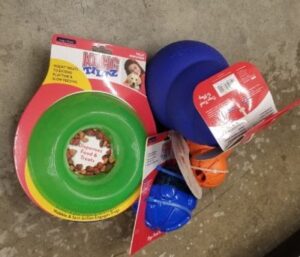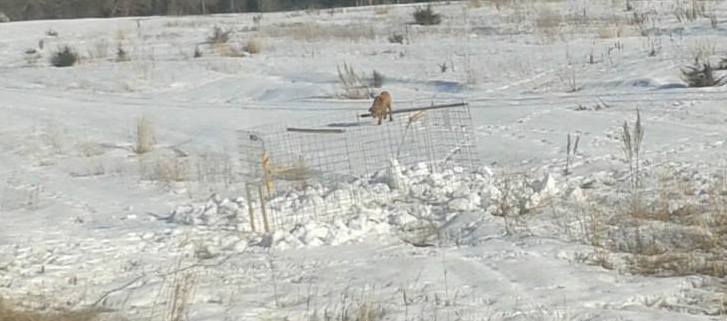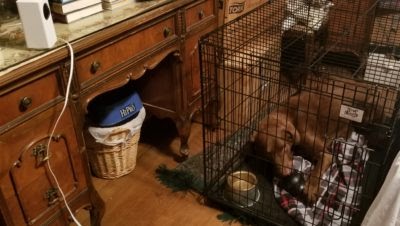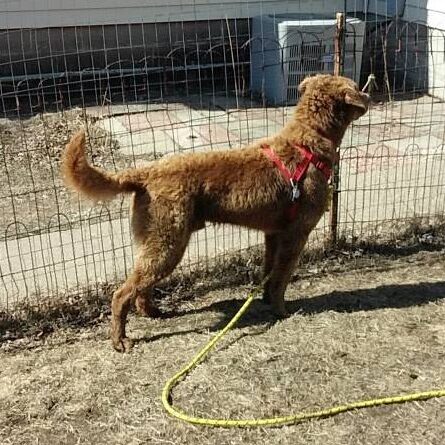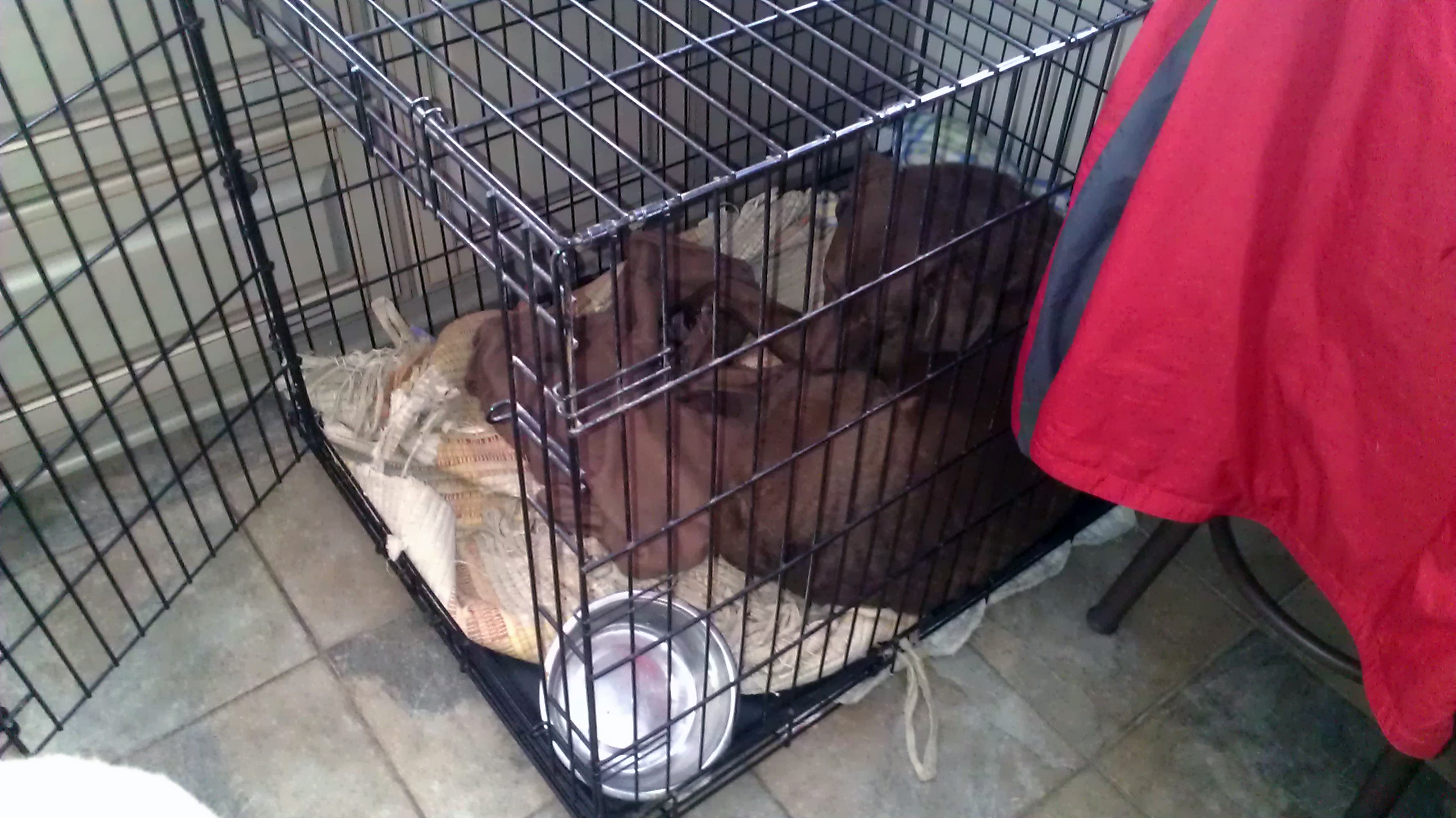Signs of Separation Anxiety in Dogs
Dogs suffering from separation anxiety become agitated when their guardians prepare to leave and/or leave the room or home. Separation anxiety can be in the form of:
- Urinating or pooping in the house when left alone
- Barking or howling excessively and for a long period of time
- Chewing, digging or trying to escape from their crate, the room or house
- Pacing along a specific path in a fixed pattern in a walk or a trot
- Excessive drooling and panting or other indications of distress
- Injury to themselves and destruction to the house especially near windows and doors
It is important to rule out medical causes for many of the symptoms listed above:
- Visit your veterinarian to make sure there is not another reason for the urination or pooping such as incontinence, UTI, side effect of a medication, etc.
- Is the dog completely house-trained?
- Is the dog bored and destructive out of boredom?
- Is it juvenile/puppy behavior chewing?
- Are there other environmental triggers that may be causing barking, howling or behaviors?
Reasons for Dogs to develop Separation Anxiety
There can be several reasons for separation anxiety to start. These can include:
- Change of family – moving from one home to another or from the shelter to a home
- Change of schedule – a member of the family switches from working one set schedule to a new one. Or someone who was always home is now leaving for several hours at a time.
- Change in the household residents such as adding new member(s) moving into the house or the departure of member(s) such as a child going off to college
- Moving of the entire family to a new home
- Illness of dog or even of a family member
Suggested treatments and hopefully solutions
Our goal is to alleviate the dog’s underlying anxiety by teaching him to enjoy, or provide him with the tools and/or medication (if necessary) to tolerate being left alone.
WiFi Camera

Camera setup
Get a WiFi indoor camera so you can watch your dog from your smartphone or laptop. I set my camera up in the room with the dog and then go outside to the curb and watch the dog’s behavior.
- How severe is the anxiety? Scale of 1 (minor agitation)- 10 (throwing body at barrier, barking loudly, drooling and panting hysterically)
- Will they hurt themselves or your property?
- How long does the behavior last? Less than 5 minutes?
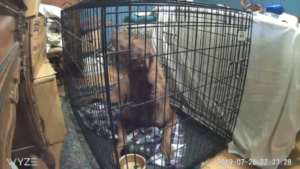
Screen captures from the camera Intermittently for hours? Constantly until point of exhaustion for hours
You can watch camera video feed and even record events to review with trainer and/or veterinarian.
From the camera analysis you can determine severity and begin to formulate a plan.
Interactive Food Toys and Classical Music
If you did not rate the behaviors as above a 5 on the scale and they were not constant for more than 30 minutes, I would recommend trying Interactive toys on departure and playing Classical music on a radio in the room.
- Stuffed frozen Kongs – https://www.kongcompany.com/recipes
- Interactive food toys such as a
- Kong Wobbler, Tiltz, Rewards, etc – https://www.kongcompany.com/dog/play-type/interactive
- Busy Buddy Kibble Nibble, Barnacle, etc
- https://store.petsafe.net/toys/l/treat-dispensing-toy?_ga=2.104504256.1313067200.1562536961-877464290.1562536961
- There are a lot of options just make sure they are not too difficult and they are durable and safe to leave with your dog unsupervised.
- Classical or piano music or even better the music specifically created for dogs such as Through a Dog’s Ears. If Classical or piano is not an option, Country music is okay but PLEASE AVOID talk radio or any type of rock, rap or music with loud, weird, fast or varied tempo, that makes a dog anxious. I DO NOT recommend leaving a television on as it is too variable and the sounds of strange voices in the house can often make anxiety worse!
Straw and Airline Plastic Crate
Another technique that has been found effective is straw inside a plastic/shipping dog crate.
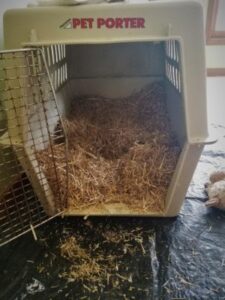 Use an airline plastic crate and fill it hip deep to the dog with straw
Use an airline plastic crate and fill it hip deep to the dog with straw- Use Straw!
Don’t use hay because that is dried grasses and dogs are more likely to eat it. Dogs don’t normally eat the straw, but you can keep an eye if you’re worried. You can use long strips of newspaper if you prefer, but it gets dirty and dusty - Put a sheet under the crate to make for easy clean up. Straw is messy in the house
- It is thought this technique works because it engages the dog’s nesting/denning instinct. Many breeders keep puppies in some sort of organic bedding for a few weeks so straw is like old home week.
- It is comforting to dogs to have something pressuring their body in the crate
- Straw encourages some crate dirty dogs to be clean, but check for wet spots. Discontinue if you’re getting more crate eliminating rather than less
- Change the straw at least weekly. They like new straw. It’s like getting clean sheets. This technique is more for crate anxiety rather than housebreaking
- If the dog digs around and fluffs the straw, so much the better
- Foraging in the crate is better than freaking out in the crate, so you can toss in some treats in the straw to further engage/occupy the dog.
- Straw helps rest time be more restful for many crate anxious dogs, but they probably still need more exercise than they’re getting
- Give the dog at least a few weeks with full hip deep straw, but then you can remove handfuls of straw per day to wean off.
- Feel free to adapt as needed for your dog. You can also combine this with other methods mentioned
Nutraceuticals
Nutraceuticals are dietary supplements used to provide medical or health benefits. There are hundreds of options out there, here are a few that I have personally witnessed success using:
- July Third from Herbsmith available at Fun Fur Pets and Wags and Whiskers in La Crosse. https://www.herbsmithinc.com/july-3rd/
- Solliquin available online at many of your favorite online stores. https://www.solliquin.com/
- There are MANY others that I have not had personal experience with and some that I have not seen an impact.
Pharmaceuticals
Pharmaceuticals – veterinarian prescribed anxiety medications. I am a firm believer in anxiety medications for dogs. I have used anxiety meds for several of my dogs with GREAT success. Separation Anxiety is a HORRIBLE disorder and the best justification I have heard was “NO dog should have to experience that fear.” Why should they when we have many options and medications that can help. I will say not all veterinarians are comfortable prescribing anxiety meds and I understand that. I am NOT a veterinarian but I have done a lot of research and I have worked with several behaviorists. The information I am providing here is based on personal experience, research and presentations by Veterinary Behaviorists.
- Dogs with separation anxiety CANNOT LEARN it is okay to be left alone. They are in a state of Panic.
- Medications do NOT change a dog’s personality. Yes, there are side effects but there are lots of options to try and in the end medications will make your dog’s life much happier. All medications MUST be prescribed by a veterinarian. If your veterinarian is not familiar or comfortable with anxiety medications, PLEASE aske them to either contact a Veterinary Behaviorist for advice or refer you to a veterinarian with experience in anxiety meds.
The most effective anxiety medications impact the dog’s serotonin levels in their brain. Serotonin is a neurotransmitter. It is a chemical in the dog’s nervous system the regulates behavior, awareness of pain, appetite, movement, body temperature and heart and lung function. Serotonin is responsible for feelings of well being, calmness, relaxation, confidence and concentration. - Basic overview of some Pre Departure Medication options:
- Alprazolam or lorazepam works on the dog’s serotonin. Needs to be given 30-60 minutes before departure and will last 2 – 4 hours.
- Trazadone works on the dog’s serotonin levels. Given 90 – 120 minutes prior to departure and works for 6 – 8 hours.
- Gabapentin primarily used to treat chronic pain and can be used as a mild sedative. Must be given 90 – 120 minutes prior to departure and can last up to 12 hours.
Note: I have personally not had success with this medication for any of the dogs I have worked with for separation anxiety or vet visit anxiety. - Clonodine – works with the dog’s serotonin levels. Must be given 90 – 120 minutes prior to departure and last for 4 – 6 hours.
Note: I have personally had a lot of success with this particular medication in both separation anxiety and general anxiety as a bridge while bringing on a daily anxiety medication. - DO NOT USE – ACE (Acepromazine) this medication does NOT have any impact on the brain. It sedates the body and the dog’s brain is not provided with any relief. I can only imagine how HORRIBLE this medication is for a dog with anxiety. “Not only am I scared but now I CANNOT MOVE!”
- Basic overview of Daily Medication options – these are medication that must be delivered every day and they take 4 – 8 weeks for the full effect to be apparent. These medications work on the serotonin levels of the dog’s brain.
- Fluoxetine – Increases serotonin in a dog’s brain. 4 – 6 weeks before full effect can be seen. Side effects for 1 -2 weeks can be lethargy and decreased appetite. If these side effects last for 3 – 4 weeks, consider trying a different medication.
- Paroxetine – has similar effects as Fluoxetine but can have less impact on the G.I. system.
- Sertraline – similar effects as Fluoxetine. I have one dog that did not show any improvement in general anxiety on Fluoxetine. We put him on Sertraline and he has been showing increased improvement.
More information on Daily and Situational behavior medications.
Separation anxiety may improve as the dog’s situation becomes more stable and they gain confidence. Consistent routines can help some dog’s anxiety become better in the long run however sometimes consistent routines initially are very scary. Remember the dog is NOT doing this on purpose, they are in a STATE of PANIC. They cannot LEARN to not do it. We must provide them with tools whether it is environment, medications or both to help them manage their fears. Estimates are that 17 – 29% of dogs are impacted by separation anxiety. Dogs with increased risk of separation anxiety are: single dog households, strays, and adopted dogs. We also find separation anxiety is slightly more prevalent in male dogs (60%).
There are lots of methods, techniques, equipment, sprays, collars, nutraceuticals and medications that are available. I have just touched on the methods, equipment, nutraceuticals and medications I have personally had success with or a trusted friend or professional has experienced success using. Most important advice is to SEEK assistance from your VETERINARIAN if the separation anxiety is severe or getting worse. The dog is suffering and that is no way for any living being to live.
Sources:
Separation Anxiety – https://www.aspca.org/pet-care/dog-care/common-dog-behavior-issues/separation-anxiety
The role of Serotonin in dog anxiety – https://www.horseandpethealth.com/pet-health/role-seratonin-dog-anxiety/
Side Effects of Anxiety Medications in Dogs – https://www.petmd.com/dog/conditions/neurological/c_dg_serotonin_syndrome
Separation Anxiety presentation by Dr Erica Hawker at Animal Behavior Science Conference 2019

